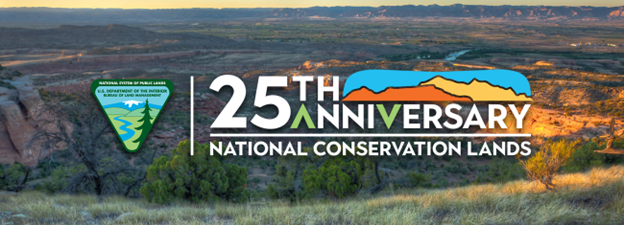Enjoying Outside - Happy 25th Anniversary National Conservation Lands!

You’ve probably enjoyed at least some portion of National Conservation Lands and may have not even known it. Primarily focused in the western United States, National Conservation Lands comprise over 38 million acres that includes California Desert, Conservation Areas, National Monuments, National Scenic and Historic Trails, Wilderness Areas, Wilderness Study Areas, and Wild and Scenic Rivers. With such a vast collection you can imagine the landscape and artifacts found in the National Conservation Lands program varies greatly ranging from brawny Alaskan tundra, dynamic coastlines, enchanting red-rock deserts, noble historic lighthouses, intricate waterways and serene mountains. National Conservation Lands provide public access to recreational and scientific research opportunities along with protected critical habitat for sensitive species and wildlife migration corridors. While some of the National Conservation Lands are remote, so much that for thousands of years they were protected just by their location or accessibility. Other National Conservation Lands are nearby and easily accessed, especially now that today one in six people live within 100 miles of federally protected public land.
The National Conservation Lands program was created in 2000 by conservationists in response to mounting threats to cultural resources, waterways and public lands managed by the Bureau of Land Management (BLM). The BLM currently manages roughly 245 million acres of public land, more land than any other agency in the United States. But, only about 15%, around 37 million acres of those protected areas are designated as National Conservation Lands - lands that possess some of the last remaining wild, ecologically sensitive and culturally rich areas in the Western United States. They are often described as the landscape between more commonly known and familiar public lands such as National Parks and National Wildlife Refuges. Protecting these “in between areas” means safeguarding large, intact landscapes, ecosystems and culturally rich areas as one unit. These areas are managed to honor the ties that indigenous communities have to their lands while also embracing diverse interests and uses for future generations.
The National Conservation Lands Foundation was formed in 2007 and combined a local grassroots network with a sophisticated national presence to permanently protect more land as well as offer support to other like-minded community-led organizations and advocates who all share a love of public lands. Today, the National Conservation Lands program includes 28 National Monuments (including our favorite, The Berryessa Snow Mountain National Monument), 25 National Conservation Areas, 21 million acres of Wilderness and Wilderness Study Areas, 2,700 miles of Wild and Scenic Rivers and 6,000 miles of Historic Trails. Not bad for only 25 years worth of work!
To learn more about National Conservation Lands in California visit : https://www.blm.gov/programs/national-conservation-lands/california
To learn more about our friends at Conservation Lands Foundation visit : https://www.conservationlands.org/
-Kristie Ehrhardt (kehrhardt@tuleyome.org)
Tuleyome Land Conservation Program Manager
RECENT ARTICLES






